Table of contents
Kaffir lime leaves ( kaffir leaves, kaffir lime leaves) are the leaves of the kaffir lime ( Citrus hystrix). Thanks to their piquant, fresh citrus aroma, they are used in cooking as a spice.
Use in the kitchen
What are kaffir lime leaves? What is a kaffir leaf? They are leaves of the kaffir lime and are used as a leaf spice in Thai cuisine. They are similar to the bay leaves we are familiar with, but the leaves of the kaffir lime look as if two bay leaves had grown together lengthways. This impression is created because the leaf stalks are very broad ("winged"). Bay leaves are mainly used dried, whereas kaffir is used fresh (raw). The fresh kaffir leaf is covered with a layer of wax that makes it shine green. When rubbed between the fingers, the kaffir lime leaf gives off an aromatic lemon scent. The kaffir lime (fruit) is similar in size and color to the fruit of the more well-known common lime ( Citrus x latifolia). However, it has much less juice and its skin is uneven and coarsely warty.
Kaffir leaves are often used in Thai cuisine; in Thailand they are called Bai Makrut.
Before cooking, rinse the fresh kaffir leaves thoroughly, let them dry or gently dab them. Then cook them whole in the dishes and remove them just before eating. Chopped very thinly, the otherwise tough kaffir lime leaves can also be eaten, e.g. in curry. This way they develop their full aroma. When preparing, note that the midrib and stem of older leaves can taste bitter. If this bothers you, you can tear the leaf apart and remove these parts before cooking.
Kaffir lime leaves go well with ingredients such as coconut milk, garlic, onions, ginger, galangal, chili and basil. They are mainly used in Thai and other Asian dishes. Their special lemon scent goes well with soups, salads, stews, rice or vegetable dishes. The typically fresh aroma of kaffir leaves characterizes the Thai soups Tom Yam (or Tom Yum, here is the recipe for a vegan Tom Yum soup) and Tom Kha Gai. In Thailand and Cambodia, spice pastes with kaffir lime leaves as an ingredient are also known. They are also suitable as a decoration for fruit salads, ice cream sundaes, lemonades and cocktails.
What can you use to replace kaffir leaves? If you don't have kaffir lime leaves on hand, you can replace them with the peel of a fresh lime, lemon grass or lime juice. Some people also replace kaffir leaves with the leaves of the lemon myrtle ( Backhousia citriodora). The taste of these substitute products is not quite the same, however. Although not nearly as aromatic, dried and ground kaffir lime leaves are very easy to dose.
Kaffir leaves should not be confused with curry leaves. These also have a fruity, slightly citrus smell. However, they are mainly used in Indian cuisine.
Vegan recipe for Tom Kha Paste (Tom Khaa)
Ingredients: 2 stalks lemongrass (or 1 tbsp lemongrass powder), 60 g fresh galangal (Thai ginger) (or 1 tbsp ground), 60 g fresh ginger, 2 onions, 4 cloves of garlic, 2 tsp chili powder, 4 tbsp lime juice, 3 tbsp brown sugar, 3 tbsp coconut oil (alternatively rapeseed oil), 2 tsp salt, 8 fresh kaffir lime leaves.
Preparation: Remove the hard, lower part and the outer leaves from the lemongrass and chop them into small pieces. Peel the ginger, onions and garlic and chop them into large pieces. Chop the kaffir lime leaves very finely or use powder. Put all the ingredients in a high-performance blender and puree to a homogenous mass. Filled into a screw-top jar, this paste will keep in the fridge for a few days. Thai Tom Kha paste is used for curries or soups of the same name.
Recipe for tea with kaffir leaves
Brewed with hot water, the fresh leaves also taste good as tea. Cooled and slightly sweetened, this kaffir lime leaf tea is a very refreshing thirst quencher, especially in summer.
Vegan recipes with kaffir lime leaves can be found under the note: " Recipes that have the most of this ingredient ".
| Not only vegans or vegetarians should read this: Vegans often eat unhealthily. Avoidable nutritional errors. |
Purchasing - Storage
Where can you buy kaffir lime leaves? European supermarket chains such as Coop, Migros, Denner, Volg, Spar, Aldi, Lidl, Rewe, Edeka, Billa, Hofer hardly stock fresh kaffir lime leaves. Organic supermarkets such as Alnatura and Denns do not stock them either. Spice shelves in well-stocked supermarkets are sometimes stocked with dried or ground kaffir lime leaves. You can find fresh and definitely dried leaves in specialty shops, Asian shops and Thai markets. Fresh kaffir lime leaves can also occasionally be found online, and dried leaves are very readily available online.
Although organic kaffir lime leaves do exist, the market for them is still very small. If possible, look for organic quality, as conventional cultivation of citrus fruits uses a lot of pesticides. Alternatively, you can buy a kaffir lime tree from a garden center. The evergreen tree will then provide you with fresh kaffir lime leaves at any time.
In the DA-CH countries, kaffir leaves are available (almost) all year round thanks to long-distance imports. Kaffir leaves can be harvested all year round, especially from young trees. Therefore, there is no actual season. 15
The availability of kaffir lime leaves varies depending on the size of the store, catchment area, etc. Our recorded food prices for the DA-CH countries can be found above under the ingredient image - and by clicking you can see their development at various suppliers.
Storage tips
You can store fresh kaffir lime leaves in the vegetable compartment of your refrigerator for about 2-3 days. If you have bought a large quantity, freeze the leaves whole or chopped to keep them in stock, this is the best way to preserve their aroma. If stored in a plastic bag and frozen, they will last a very long time, there is no expiration date for them.
The dried or ground kaffir leaves will keep for a very long time if kept cool, dark and hermetically sealed, but they quickly lose their fine lemon aroma.
Ingredients - Nutritional Values - Calories
The macronutrients are calculated from dried leaves and information on the water content in fresh leaves.
100 g of kaffir leaves (raw) have an energy content of 53 kcal. In terms of macronutrients, they provide little fat and protein. Carbohydrates and fiber make up the majority.
The penetrating lemon-like scent of kaffir lime leaves comes from the essential oil they contain. This mainly contains citronellal (48.2%), citronellol (14.3%) and citronellyl acetate (7.8%). 15
The complete ingredients of kaffir lime leaves, the coverage of the daily requirement and comparison values with other ingredients can be found in our nutrient tables. In the article Nutrients explained you will get a detailed insight into the topic.
Health effects
The health effects of kaffir lime leaves are due to the secondary plant substances they contain.
There is evidence that the alcoholic extract of kaffir lime leaves is effective against herpes viruses. 4
Studies show that kaffir leaf extracts reduce cervical and neuroblastoma cell lines and are therefore suitable as an anti-cancer compound. 5 An effect has also been demonstrated in vitro against leukemia cell lines. 6
Secondary plant substances
Our article on secondary plant substances provides an overview of the classification of substance groups, their occurrence in foods and possible effects on humans.
However, it should be noted that the composition of secondary plant substances in kaffir lime leaves can vary depending on the variety, time of harvest and growing conditions. Therefore, quantities are only of limited use and should only be understood roughly.
Dangers - Intolerances - Side effects
The furocoumarins contained in the peel and pulp of the kaffir lime can cause severe phytophotodermatitis. 7,8 Furocoumarins that come into contact with the skin react with the UVA and UVB rays of sunlight. Symptoms similar to burns occur. Furocoumarins are carcinogenic when exposed to UV light because they form covalent bonds with the pyrimidine bases of DNA. 9
Danger of confusion
The leaf stalks of the Ichang lemon or Ichang papeda ( Citrus ichangensis) are winged just like those of the kaffir lime ( Citrus hystrix). The aroma of the Ichang lemon leaves does not come close to that of the kaffir lime leaves. There is no danger of poisoning.
Folk medicine - natural medicine
The leaves of the kaffir lime play an important role in Thai folk medicine as a digestive aid. It is believed that the leaves purify the blood and at the same time help to keep teeth and gums healthy. Kaffir leaves are also used for colds and coughs. 15
The juice and peel of the kaffir lime have long been used as a shampoo additive in the countries where it is grown. In this form, kaffir limes are said to kill head lice ( Pediculus humanus). 3
Kaffir lime juice is also used to treat mosquito bites and for prevention. 3 The scent of Mauritius papeda also has an insecticidal effect, e.g. as a mothball substitute or against mosquitoes. However, due to the furocoumarins it contains, skin rashes can occur after use (see above under Dangers - Intolerances - Side effects). 8
Ecological footprint - animal welfare
The ecological footprint of a food depends on various factors. The type of agricultural production (conventional vs. organic), seasonal, regional or domestic production or import by truck, ship or plane, different types of packaging and whether the goods are fresh or frozen all play a decisive role. 10
Despite extensive research, we were unable to find any precise information on the carbon footprint of kaffir lime leaves. However, the carbon emissions should not be underestimated, as they usually have to be transported several thousand kilometers before they can be bought in stores.
We could not find any data on the water footprint of kaffir leaves. In general, the water footprint of spices is around 7000 l/kg. In comparison, vegetables have 300 l/kg and grains 1600 l/kg. 13
There are initiatives and labels for spices such as SSI ( sustainable spices initiative) or NSSP ( National Sustainable Spice Program), which promise certain sustainability standards. But Rainforest Alliance and UEBT ( Union for Ethical Biotrade) also have programs that bring the cultivation of herbs and spices onto a sustainable track through certain supply chain management and certification systems. In addition to preserving biodiversity in the countries where the spices are grown, workers' rights are also secured. Standards for farms and supply chains should take into account the sustainable aspects of production and trade. However, the extent of implementation varies greatly from organization to organization. 14
In conventional agriculture , synthetic herbicides and pesticides are used to protect against unwanted plants and insects. However, these are not only proven to harm the environment, but can also have direct negative effects on people. Often, residues of the pesticides used during cultivation can still be found in the end product. Ideally, you should buy kaffir leaves from organic farming.
Worldwide occurrence - cultivation
The small-growing kaffir lime tree comes from Asia. The plant is most widespread in Southeast Asia. 11 It originally comes from Indonesia, Malaysia and Thailand. 5
The most important producing countries for kaffir lime leaves are Thailand, Indonesia, Malaysia and India. 15 Since kaffir leaves are a niche product, there are no statistical figures on global cultivation.
Found in the wild
There are numerous species of the subgenus Archi-Citrus between the Himalayas and Malaysia, but Citrus hystrix prefers maritime locations. Other well-known wild species are C. combra and C. macroptera. It is assumed that these primitive species are the predecessors of today's cultivated species Citrus medica (citron) , C. x limon (lemon, lime), C. x aurantium (bitter orange), C. x aurantiifolia (true lime), C. x sinensis (orange) and C. grandis (pomelo). 2
Cultivation - Harvest
Kaffir limes usually grow as an evergreen bush that can reach a height of up to 2 m and has thorny branches. The leaves are unusual: since the stem is winged, this gives the impression that two leaves have grown together. The small, white flowers give off a very pleasant scent. This produces lime fruits with a diameter of around 5-6 cm. Their skin is thick, wrinkled and warty. As they ripen, the fruits turn from green to yellow. The difference to a "normal" lime is mainly the amount of juice: Kaffir limes contain comparatively little juice and many seeds. In this subgenus, the skin and the pulp are difficult to separate. 2
Kaffir leaves can be harvested all year round, especially from young trees. Since kaffir lime is mainly used as a food flavoring in the form of fresh leaves (whole, torn or thinly sliced as required), cleaned, fresh leaves are packed in plastic bags and exported in refrigerated containers around the world. Sometimes the leaves are exported frozen to preserve freshness. Dried leaves are less aromatic and flavorful, but are easier to transport and have a longer shelf life. 15
Growing as a potted plant
If you buy a lime tree, you should repot it in a larger container. You need a permeable substrate for optimal growth of the fine roots. For drainage, put stones, clay shards or expanded clay in the bottom of a pot and plant fleece on top, because kaffir lime trees do not tolerate waterlogging. Sprinkle some of the citrus plant soil on top (citrus soil / lemon soil is slightly acidic with a pH value of 5.5-6.5). Dip the root ball briefly in low-lime water, put it in the pot and add more citrus plant soil on top, pressing it down a little. Rainwater is best for watering, but only moderately. The top layer of substrate should never be soaked through; only water again when the top of the soil is dry. 12
Regular pruning of the tree ensures a beautiful, compact growth. Because of the thorny shoots, it is best to wear gloves. The best time for pruning is in spring, before new growth appears: Dead branches and those that grow inwards are cut or pinched off with disinfected tools. Shoots that are too long can be shortened all year round. 12
In summer, a sunny, sheltered spot outside is ideal. To overwinter, the tropical plant needs a bright, frost-free location with temperatures of 5-10 °C, e.g. an unheated winter garden, a stairwell, a cellar or a frost-free, bright garage.
Further information
The kaffir lime leaves belong to the kaffir lime ( Citrus hystrix), also called kaffir lime, Mauritius papeda or makrut. Botanically speaking, they belong to the rue family (Rutaceae) and the genus of citrus plants ( Citrus).
The kaffir lime is classified in the Papeda subgenus, which is why it is not so closely related to the citrus fruits we know. Hence the rarely used Latin name Citrus papeda.
Alternative names
Kaffir leaves are also called Mauritius Papeda leaves or Bai Makrut. Kaffir lime leaves or Kaffir lime leaves are also common spellings. The leaves are also called kaffir leaves, lime leaves and sometimes Indian or Indonesian lemon leaves. An incorrect spelling is kefir leaves.
In English, the fruit is commonly known as makrut lime, Thai lime, wild lime, kieffer lime or kaffir lime. The leaves are called kaffir lime leaves or Indonesian lime leaves.
The fruit itself is also known in German as Thai lime, limonelle or kaffir lemon. In France, Spain and Italy it is called combava. In Indonesia it is called jeruk purut and the leaves are called jeruk purut.
Where the name kaffir lime comes from is not clear. The term "kaffir" is used in several languages. In Arabic it means "infidel", derived from the word "kafara". An Anglo-Indian dictionary states that the term is a swear word. In South Africa, white immigrants used it as a derogatory term for the native Africans. Due to these derogatory meanings, the term "kaffir" is probably used for this type of citrus because it was long considered inferior to other limes. This was before the unique taste of the oil in the leaves and peel was discovered. 15
Other uses
Kaffir lime leaves can also be used as a scented spice by adding them to a hot bath or by putting them in a crushed form in an aroma lamp. If your skin is not too sensitive and no negative reactions occur, the leaves can also be used as a body scent or a light perfume. To do this, rub the crushed kaffir lime leaves into your hands or temples.
The juice of the kaffir lime (fruit) is also used as a cleaning agent for clothes. In Cambodia, the use of holy water with slices of kaffir lime fruit for religious ceremonies is common.
Bibliography - 14 Sources (Link to the evidence)
| 2. | Brücher H. Tropische Nutzpflanzen. Ursprung, Evolution und Domestikation. Springer: Berlin, Heidelberg, New York. 1977. |
| 3. | Staples G, Kristiansen MS. Ethnic culinary herbs: A guide to identification and cultivation in Hawai'i. University of Hawaii Press. 1999. |
| 4. | Fortin H, Vigor C et al. In vitro antiviral activity of thirty-six plants from La Reunion Island. Fitoterapia. 2002;73(4):346-250. |
| 5. | Tunjung WA, Cinatl J et al. Anti-cancer effect of kaffir lime (Citrus hystrix DC) leaf extract in cervical cancer and neuroblastoma cell lines. Procedia Chemistry. 2015;14:465-468. |
| 6. | Chueahongthong F, Ampasavate C et al. Cytotoxic effects of crude kaffir lime (Citrus hystrix, DC) leaf fractional extracts on leukemic cell lines. Journal of Medicinal Plants Research. 2011;5(14):3097-3105. |
| 7. | Dugrand-Judek A, Olry A et al. The distribution of coumarins and furanocoumarins in citrus species closely matches citrus phylogeny and reflects the organization of biosynthetic pathways. PLOS ONE. 2015;10(11). |
| 8. | Koh D, Ong CN. Phytophotodermatitis due to the application of Citrus hystrix as a folk remedy. British Journal of Dermatology. 1999;140(4):737-738. |
| 9. | Schimmer O. Die mutagene und cancerogene Potenz von Furocumarinen. Pharmazie in unserer Zeit. 1981;10(1). |
| 10. | Reinhardt G, Gärtner S, Wagner T. Ökologische Fussabdrücke von Lebensmitteln und Gerichten in Deutschland. Institut für Energie - und Umweltforschung Heidelberg. 2020. |
| 11. | Rehm S. Espig G. Die Kulturpflanzen der Tropen und Subtropen. Anbau, wirtschaftliche Bedeutung, Verwertung. Eugen Ulmer: Stuttgart. 1976. |
| 12. | Hausgarten.net Kaffernlimette, Kaffir-Limette, Citrus hystrix - Pflege-Anleitung. |
| 13. | Mekonnen MM, Hoekstra AY. The green, blue and grey water footprint of crops and derived crop products. Hydrol. Earth Syst. Sci. 2011;15:1577-1600. |
| 14. | Wenzig J. Nachhaltigkeitsclusterung von Gewürzen. Forschungsprojekt: ZNU Zentrum für Nachhaltige Unternehmungsführung. 2023. |
| 15. | Wongpornchai S. Kaffir lime leaf. In: Peter KV (Ed.) Handbook of Herbs and Spices (second edition). 2012, 319-328. |

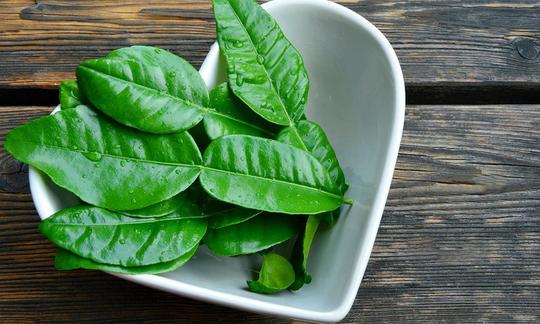

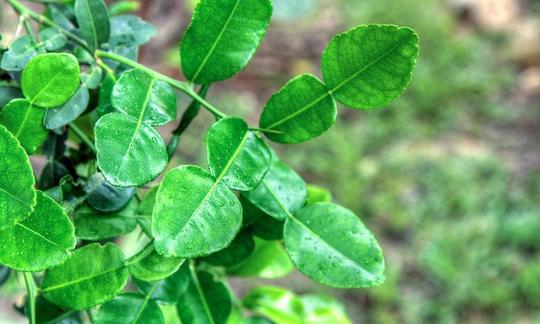

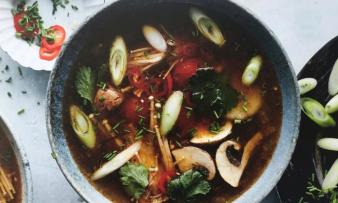
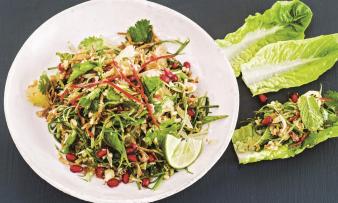
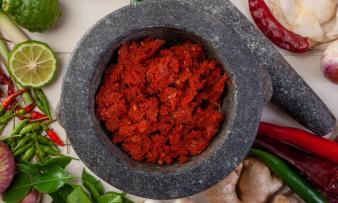


Comments